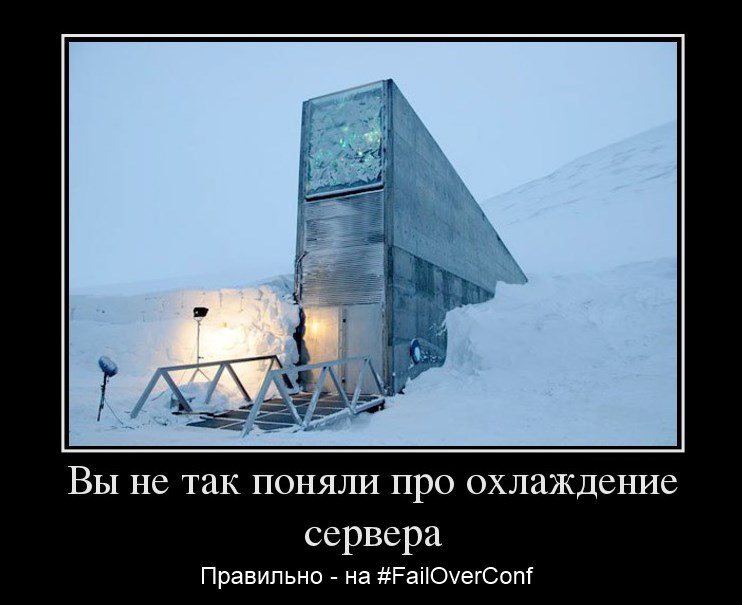Friday's announcement #FailOverConf. And buns to participants

Before the conference #FailOverConf , which will be held on May 23 in Moscow, a little more than a month remains. And we decided to make a pleasant surprise for those who have time to register at an early stage, before April 30.
In addition, they prepared a small overview of some reports - in a special Friday format.
Let's start with the pleasant.
')
For anyone who has time to register and pay for their participation until April 30 (inclusive):
- Special price for participation in the conference: 5,000 rubles - full-time participation, 3,000 - online broadcast. From May 1, the price rises.
- a gift from us: all materials (presentations and videos of speeches) of the two previous #FailOverConf 2013 conferences held in Moscow and Kiev.
You can register for the conference and pay for participation on the FailOver Conference 2014 website.
And now we will introduce you to some speakers and their presentations at the upcoming conference.

Alexander Lyamin , CEO of Qrator , knows about DDoS, perhaps everything. What are the attacks, how to distinguish between their types, how to assess the scale of the disaster that has fallen on your site, and - most importantly - how to resist it. All this is in the report of Alexander “You VS DDoS: available counter. measures. "

Several years ago, the “clouds” ceased to be just a weather phenomenon, and became a serious alternative to the traditional “hardware”. First, with distrust and caution (“Some kind of marketing nonsense ...”), then consciously and confidently, but we began to actively use the “clouds” in various projects. And now, even though it was worth doing earlier, it’s time to figure out how to properly build your “cloud”. About one of the most famous cloud platforms - Openstack - tell Nikolay Dvas (Webzilla) .

If your site is located, for example, on a server in Hetzner, and its main audience is in Russia, do you know how to evaluate the routes by which TCP packets run between your site and the client’s browser? Even if you know (know how to use traceroute), do you understand how this affects the speed of the site? How to speed up https? What is the difference between the transfer of a small file with css from a large video? All these questions speak of one thing: at #FailOverConf, along with Stanislav Nikolov (UCDN), we will parse the CDN - how it works, how it works and what really helps websites.

We all know how to deal with slow queries in MySQL. They turned on the slow query log, set EXPLAIN on the heaviest ones, tried to build indexes ... Just? And how to understand exactly where it slows down? Opening tables, network transfer? And if there are no obviously “bad” requests, but there is a feeling that it “slows down”? How to measure this "feeling"? Debugging MySQL performance is a whole science! And we will study it together with Sveta Smirnova (just from MySQL / Oracle ).

By some estimates, up to 40% of all traffic on the Internet is now transmitted to mobile devices. And if only recently you could afford to ignore the meager share of mobile browsers in the attendance statistics of your project, now you can’t. If you don’t make mobile or adaptive versions of sites, if you don’t take into account weaker mobile browsers, it’s far from ubiquitous 4G, slow 3G (or, oh, horror! - EDGE, GPRS) and don’t prepare your site for such harsh living conditions - just losing customers. To prevent this from happening, we are starting the client side optimization with Yuri Ustinov (Rusonix) .

A harsh Siberian peasant sent a Japanese chainsaw. They decided to try it. They put a board on it.
“Zipper,” said the Japanese chainsaw.
“Hm,” said the harsh Siberian men, and laid down a log.
“Vzh-zhik,” said the Japanese chainsaw.
- Hmm, - said the harsh Siberian men and put a whole tree.
“Vzh-Zhik,” said the Japanese chainsaw.
“Hmmm,” said the harsh Siberian men, and laid down the rail.
- Vzh-Zh-ZhK! - said the Japanese chainsaw and broke.
- Aha-ah! - said the harsh Siberian men ... And they went to cut wood with axes.
The load testing of the site helps to understand what conditions of work, what load and attendance will become the very “rail” on which the site may break. Alexey Lavrenyuk (“Yandex”) will talk about the organization of the load testing process: why it is needed, what questions it will answer, how to reduce the time and human resources costs for load testing.
* * *
This is a review of only a small part of the reports. The full program can always be viewed on the site. Now the program is being formed, the full version will be available in a few days. But now we can say that FailOver Conference is reports from 20+ practicing experts, 16 hours of live implemented cases, 960 minutes of information on fault tolerance, cloud and iron architectures, development quality, testing, CDN solutions, databases, backups, anti-DDoS attacks, and many, many other things.
Register and come ! It will be cool and very useful!
Source: https://habr.com/ru/post/220853/
All Articles